Scrolling through the Magnum Photos website, I was struck by the sheer number of photographs that were stunningly brilliant. Normally when viewing a photography gallery or portfolio, there are a couple images that catch my eye and I leave with only a few images in mind. However, on the Magnum website, I could not find one image that I didn’t particularly take interest in, or considered unworthy of its revered status. While every photographer is capturing images of similar subject matters, either of political or historical significance, no two photos are even remotely similar, each collection and portfolio is incredibly diverse. What I can deduce from browsing through each photographer is that they are perhaps hired by Magnum because of their innate ability to capture dramatic moments, each containing a sense of heightened realism that invites the viewer to find every detail in the frame, providing layers of stories and emotions. Two photographers that caught my attention were Hiroji Kubota and Nikos Economopoulos, both of whom have captured images that are incredibly moving and that I found to have particular aspects to their photography that were notable.
Hiroji Kubota is a Japanese photographer whose work is largely concentrated in Japan, China, Taiwan, and North Korea, but has also worked in United States, most notably photographing the Civil Rights Movement in the 1960s and the March on Washington. He attended Waseda University and studied political science, and shortly after his graduation in 1962 he enrolled in the University of Chicago, where he met several Magnum photographers and started working as a freelancer. He was then discovered and became a Magnum member in 1965. He is the winner of numerous prestigious photographic awards including the Nendo Sho and the Mainichi Art Prize.
An aspect of Kubota’s works that I believe makes his style unique is his capturing of detail, often times in large groups or gatherings. For instance, in two images he shows female ship labors and male coal miners. In the photograph of the women, there is only one pair of eyes that can be seen under the protective masks that each worker is wearing as they clean an old ship, the temperature feels hot and uncomfortable. In the coal mine photograph, a long line of male workers sit inside railroad cars, cramped and tired, perhaps on their lunch break or at the end of a long day. Both photographs, through different details, accomplish the same reaction: empathy with the workers and feelings of stress and tiredness. In his works taken in North Korea, his use of groups and scale often times imply a theme of sameness. He shows young girls at a dance class, young boys on a trolly ride, wealthy townsmen in a barber shop and government officials all bowing down to a statue of Kim II Sung. In each of these images, the subjects share an overwhelming cohesiveness, whether it be in dress, expression, or movement/positions, and this is enhanced by his frequent use of color film. What ultimately draws me to Kubota’s work is his uncanny ability to place himself in front of many people and manage to capture details that would seem otherwise impossible or too fleeting to spot.
Nikos Economopoulos is a Magnum photographer originally from Greece whose work is most apparent in his homeland of Greece as well as the Balkans. Originally a student of law, Economopoulos did not begin taking photographs till he was 25 years old, a late start for a career that usually begins at a young age. He was inspired by Cartier-Bresson and chose his first subject matter as the divide he saw between Greeks and Turks. He became affiliated with Magnum in 1990 and was in-house by 1994. He is also the winner of many prestigious awards including the Mother Jones Award for Documentary Photography, and currently resides in Athens where many of his works are on permanent display in Centre Méditerranéen de la Photographie and Benaki Museum in Corsica and Athens, respectively.
If there is one Magnum photographer who utilizes drama to it’s fullest potential, it just may be Economopoulos. His images appear as if they could have been staged, evoking emotions and visuals that are both surreal and visceral. His use of only black and white also enhances his dramatic style, allowing shadows and bright spots to be accentuated and noticed more than if they were in color. His portraits are what first caught my eye when browsing his works. In every photo he takes of another person or multiple subjects, there is something within the frame that is deeply intriguing. It may be a small detail such as the shape of their mouth, the motion of their hand, or the wrinkles in their skin. Some aspects are much more pronounced, such as a large wine stain around a cracked bottle on the street, with a woman attempting to find her balance, or an honest, contemplative, and concerned expression on a mother’s face as she looks at her child. Economopoulos’ most intriguing photograph to me was his image of a man at a political rally, with a butterfly on his shoulder. His expression is honest, and intense, and one can’t help but hope the butterfly landed there for a reason, just for a quick moment, perhaps encouraging/supporting the protestor, or giving him some good luck. Economopoulos’ photographs seem to have a life and story behind them and are in constant motion, with every frame I felt as if I was watching a stylized film, and this resulted in me being more interested with each image I saw.
– Tristan Oliveira
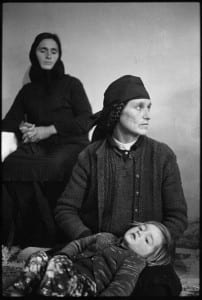
ALBANIA. Mirdita region. Perlat village. The DONDA family “forgave” the blood and has reconciliated with the SULEYMANIS. But the women still mourn the recent deads. 1998.
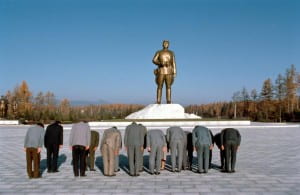
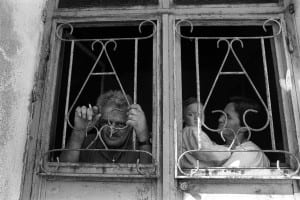
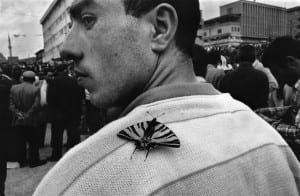
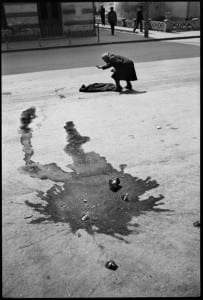
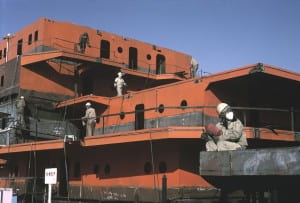
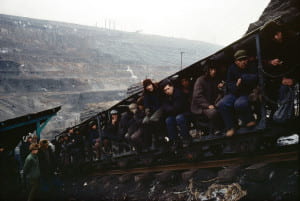
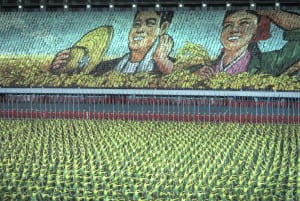
Dear Tristan,
Nice work. My thoughts in response to particular moments—
1. You say: “If there is one Magnum photographer who utilizes drama to it’s fullest potential, it just may be Economopoulos. His images appear as if they could have been staged, evoking emotions and visuals that are both surreal and visceral.” Probe deeper. What does it mean to utilize drama? Why does a photographer do this? What is the effect on the viewer? Does it work for/against the images that they appear as though they could have been staged—and why?
2. You also state: “Economopoulos’ photographs seem to have a life and story behind them and are in constant motion, with every frame I felt as if I was watching a stylized film, and this resulted in me being more interested with each image I saw.” Again, I pose questions to push you to reflect on this response. What is the relationship between film and still image? Why/how does a photo evoke film? Is it something in the aesthetics? Does it have to do with the suggestion of a longer narrative (a before and after to the moment pictured)? What is the role of movement and/or temporality in engaging a viewer to look?